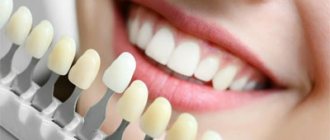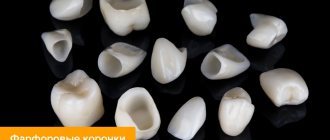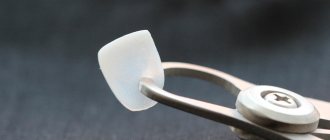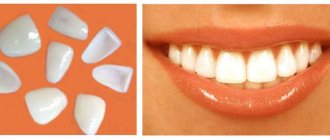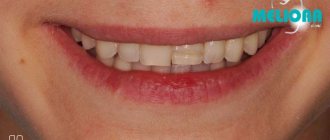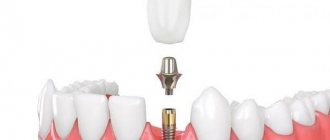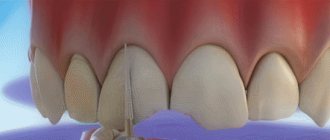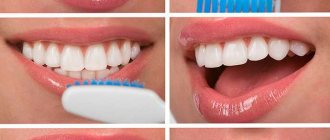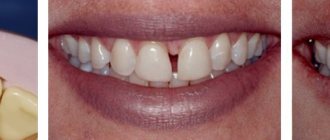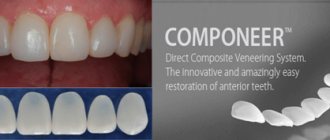Author of the article:
Anastasia Vorontsova
Photo: Computer modeling method
To install veneers, you will need to visit the dental clinic at least twice.
At the first visit, the doctor will prepare the tooth for installation of the onlay, take an impression, select the required color, depending on the color of the patient’s other teeth, and install a temporary veneer.
After one to two weeks, the patient will need a second visit to the dentist, during which the doctor will try on the manufactured veneer and fix it on the tooth.
Materials
Veneers are made from different materials, with ceramic and composite materials being the most popular.
The choice of material is one of the most important stages in the manufacture of veneers.
Modern composite materials are used to manufacture structures using the direct method.
In this case, it is best to give preference to materials that are the most reliable: not subject to abrasion, color-fast, have a wide range of colors, and are well polished.
Composite veneers
Composite dental onlays are much cheaper than ceramic ones because they are installed in one appointment, right in the dentist’s office. The surface of the tooth is prepared before installation, and then the doctor applies the composite material step by step, layer by layer. In essence, this is a large filling for the entire tooth. Composite overlays are not as durable as ceramic overlays and are prone to dulling and microcracks, so they need to be polished regularly. Usually used for the restoration of one tooth or several located in different places.
Manufacturing technique and method
Methods for making veneers can be systematized as follows:
- Layer-by-layer application. The veneer is made on platinum foil, which is pressed around a ground tooth on a plaster model. The foil holds the ceramic mass applied to it during firing in the kiln. The dental technician applies the ceramic and fires it directly on the model itself. The good thing about this technique is that it allows you to reduce distortion and shrinkage, as well as the cost of the technology.
- Casting method (injection pressing). Modeling of wax overlays is carried out on a working model, after which they are installed on the sprue and packaged in a special fire-resistant mass. Under vacuum conditions at a very high temperature, after burning the wax, a frame is formed from a ceramic or glass block under pressure. After pressing (casting), the finished plates are painted in the required color. This technique simplifies the process of making veneers and is characterized by high accuracy and excellent marginal fit. Photo: CAD/CAM technology
- Computer modeling using CAD/CAM technologies. The advantage of this technology is that the workpiece can be milled, fitted and fixed in one visit to the doctor. The process of milling the overlay takes no more than ten minutes. The structure is sawed off from the shank, after which it is fitted, polished and glazed. The finished structure is fixed on the tooth with a self-hardening material. Veneers can also be made remotely. The dentist receives an optical impression from the prepared tooth and sends the virtual model to the milling shop by email. After the veneer is made, it is delivered to the clinic by express mail.
Features of making veneers using the direct method
The thickness of the structure manufactured by direct method and manufactured in the laboratory is significantly different.
- The thickness of the veneer made using the direct method depends on the degree of expression of the tooth color.
- The lighter the tooth, the thinner the veneer, and vice versa.
- Consequently, the depth of tooth grinding is determined individually by the doctor and depends on the condition of the patient’s tooth.
The advantage of a veneer made using the direct method is that it is made on the day of visiting the dentist, which is very convenient for patients.
Veneers contraindications for use
Contraindications to the installation of veneers may include:
- bruxism (a person periodically clenches his teeth during sleep - grinding);
- the plates are attached to the tooth enamel, and its insufficient volume can serve as a contraindication;
- teeth have not erupted sufficiently;
- certain pathologies in the bite (for example, direct or deep bite);
- thin enamel, which leads to frequent chipping in large areas;
- presence of caries with complications;
- the existence of periodontal disease, periodontitis or gingivitis (first you will need to undergo certain treatment);
Other contraindications to the installation of veneers may include fragility of the teeth or the presence of large fillings. Some types of plates are made of durable material, but this is not enough to protect the tooth from damage. In such cases, it is better to use dental crowns.
Manufacturing and installation
Veneers go through the following stages of manufacturing and installation:
- The initial patient appointment usually includes taking an anamnesis, clarifying complaints, examination, and instrumental examination of the teeth.
- The condition of the gums and plaque is assessed.
- If necessary, X-ray and laboratory tests are performed.
The next step is planning, which involves researching factors such as:
- Gender, age, character of the patient.
- The smile and facial shape are assessed.
- The shape of the line of the gingival margin of the patient’s anterior group of teeth is studied.
- The individual characteristics of the tooth, shape, position, location of contact points, and the direction of the tooth axes are assessed.
- The initial parameters of the restored and intact teeth are measured.
- The size of the veneers is predicted and calculated.
- Demonstration of future restoration on a computer monitor.
Before starting the restoration, it is necessary to carry out professional teeth cleaning and only after that select the color of the veneers being made.
Types of veneer crowns
Dental clinics offer several options for crowns. The difference between them depends on the material used. Light-curing composite filling material or ceramics. Porcelain veneers can be porcelain or zirconia. Let's take a closer look at each type.
Crowns using zirconium dioxide
The basis of such plates is zirconium, which is why they have a durable frame. First, a model of the future veneer is created using computer programs, and then it is manufactured on a special automatic machine. The final stage consists of applying porcelain mass to the structure, for which high temperature conditions are used. Zirconium crowns are thin and almost transparent.
Main advantages:
- service life is longer than that of porcelain models;
- the color and structure of the material are natural;
- the whiteness of the crowns is not distorted in any lighting;
- do not stain under the influence of food dyes;
- poor quality oral care or smoking does not lead to the accumulation of plaque on the surface of the veneer;
- the material is highly biocompatible with soft and hard tissues;
- in comparison with metal, it has greater strength and less weight;
Zirconium dioxide crowns also have a significant drawback - price. One plate costs about 7,000 rubles. This amount consists of the price of the substance used, installation and complexity of manufacture.
Porcelain crowns
Veneers have gained popularity due to the characteristics of the porcelain used. They are practically no different from natural enamel and it is impossible for an ordinary person to recognize a crown. Such plates are resistant to heavy loads and staining. They are also not threatened by stains from pigmented plaque. They easily transmit light deep into the structure, which allows them to merge with natural fabrics.
There are two methods used to make porcelain veneers:
- Unpressed ceramics - ceramic masses are applied in layers, and each layer is fired.
- Pressed material – pressed under pressure using high temperatures, which allows you to achieve a stronger product.
The attending physician determines which method to use to make porcelain crowns.
How long such plates will last depends on the patient and the physiology of the teeth, what food is consumed, how oral hygiene is carried out and how capable the teeth themselves are of decay. If all wearing rules are followed, porcelain plates can last up to 20 years.
The disadvantages of veneers are the fragility of the material and the large thickness of the tooth preparation during installation. The price of porcelain veneers is slightly lower than zirconium crowns and amounts to 5,000 rubles. (a piece).
Composite veneers
Installation of composite veneers is the most common of all such services. This is due to the affordable price of the product (approximately 4 thousand rubles per piece). Such plates are made from high-quality composite filling material, and this service can be provided in any dental clinic.
Such crowns are attractive due to their low price, but one must expect that the quality in terms of aesthetic appearance and strength will be lower. Composite plates are manufactured in two ways, namely:
- Aesthetic filling – the installation process takes place during an appointment with the attending dentist. Using a special attachment, the front part of the tooth is polished, where the filling substance is applied. This fluid material is applied in a thin layer and allows you to hide minor defects.
- Manufacturing in a dental laboratory. For this method of making composite veneers, the doctor first grinds down the tooth and makes an impression of it. Already on the second visit to the dentist, the veneers are fixed to the surface. This method differs from the first in being more reliable and allows you to hide more significant errors.
Composite veneers have a significantly reduced service life (about 5 years), and the material itself is easily painted with food coloring, changing its tone.
Installation steps
Photo: Veneers on a plaster model
- Cleaning the tooth surface from plaque. Products that do not contain oils and fluoride are used.
- Selection of the required shade of filling material.
- Grinding of the front surface of the tooth with preliminary anesthesia. The required amount of enamel is removed from the surface of the tooth. The depth of enamel grinding depends on the thickness of the veneer overlay.
- Taking impressions. To take dental impressions, a special spoon is used, on which a special paste is applied, then the spoon is pressed against the teeth until the mass hardens.
- Based on the dental impressions obtained, a plaster model is cast in the laboratory to obtain an exact copy of the patient’s teeth.
- Making a veneer using a cast plaster model.
- After the doctor has prepared the teeth, a temporary veneer is made directly in the office.
- Trying on the finished veneer after its manufacture. If necessary, adjustments are made, deficiencies are eliminated, and the bite is checked.
- The tooth and veneer are washed under running water and dried with air. Then, to increase the strength of fixation of the plate to the tooth, the doctor etches the enamel with a special gel. Only after this is the veneer fixed to the tooth using special cement.
Cleaning teeth from plaque
Photo: Cleaning teeth from plaque before installing veneers.
It is a must when carrying out any types of restorations.
- Cleansing is performed with a special paste that gently cleanses the tooth of plaque and plaque.
- The dentist applies the paste to a rotating standard polishing disc or brush and cleans.
- To prevent heating, the paste is taken in large quantities.
- In this case, saliva is a kind of saliva ejector.
- After treatment with the paste, the tooth is thoroughly rinsed with water.
Ignoring this procedure leads to a fairly rapid formation of plaque around the lining and pigmented border.
Selecting the shade of filling material
With the patient in a sitting position, the color of the filling material is selected in natural light.
The tooth and reference should be wet when choosing the color, which gives them a natural look.
The choice of shade should be made in natural light.
Tools and equipment for tooth preparation
High-quality grinding of a tooth before covering it with veneer requires the use of modern, highly functional dental equipment.
- The preparation unit must have water-air cooling, a tip washing system, a fiber optic device, a scaler, a 270° rotation of the control panel around the chair, an air-water gun and a control unit for three tips.
- The spittoon must be equipped with an air vacuum group: a dust and saliva ejector, and a built-in clean water system.
- The presence of a lighting device - a reflector, creating a uniform illuminated field with clear boundaries.
- Equipping the dental chair with a silent electromechanical lift makes it possible to treat the patient in a lying position with four hands.
Modern veneers in dentistry
Thick plates requiring serious tooth grinding are almost a thing of the past. A modern veneer is a very thin plate of durable ceramic, the thickness of which does not exceed 0.2-0.4 millimeters. Some veneers are almost as thick as eye contact lenses. Such a small thickness was achieved thanks to improved ceramic masses, which are highly durable. Now even a very thin veneer will not crack, unless, of course, you try to chew on a glass bottle or a piece of concrete.
Most often, veneers are classified as aesthetic dentistry because they allow you to perfectly adjust the color and shape of your teeth. However, veneer, being a microprosthesis, also solves functional problems - to hide chips and cracks in the enamel, to remove slightly enlarged spaces between teeth, to hide pigment spots. The veneer also serves as protection for the tooth, since ceramics are not subject to abrasion, unlike tooth enamel. It is much more difficult for plaque and bacteria to gain a foothold on ceramics.
Installing veneers can also significantly rejuvenate the face - they will restore the height of the teeth, like in young people, and will serve as a framework for the soft tissues of the face, which to a certain extent will prevent the appearance of wrinkles and sagging skin. However, if conventional veneers are so successful in the aesthetic and functional restoration of a smile, then why are refractor veneers needed?
Main advantages
- Affordable price. The cost of composite products is lower than ceramic products.
- The preparation of tooth tissue for composite veneers is minimal and does not affect the deeper sensitive layers.
- Composite veneers are installed in one visit to a dentist at a medical clinic.
- The products completely match the color of the enamel of the patient’s own teeth.
Layer-by-layer method
In this method, plates are made from platinum foil, whose thickness is 0.020-0.025 millimeters.
The foil is pressed around the prepared tooth on a plaster model. The specialist applies ceramic mass to the model and fires it. The foil holds the ceramics during the firing process, which prevents possible distortion and loss of the desired shape. The model is then sanded and finishing touches are made so that the veneer can be seated on the intended tooth without any problems. This technique is economical because it does not require the use of expensive platinum foil. Therefore, manufacturing the structure will not cost a lot of money.
Types of veneers for teeth: pros and cons of different types
How much do dental veneers cost? The answer to this question will depend primarily on the type of veneers that will be used in aesthetic restoration. In modern dentistry, several main types of veneers are used and each of them has its own characteristics, pros, and cons. Naturally, the price of dental veneers will depend on their operational and aesthetic characteristics.
In this material we will provide a brief overview of the different types of veneers. After reading this review, you will be able to choose dental veneers based on cost and other characteristics that are important to you!
Caring for porcelain veneers
Subject to proper hygiene and periodic dental examinations, veneers can last for more than ten years. The service life of veneers depends on proper care.
Teeth with porcelain veneers should be thoroughly cleaned daily with a toothbrush and floss. Compliance with hygiene rules minimizes the accumulation of plaque and the risk of caries. Veneers, of course, are not subject to caries, but caries can occur in those parts of the tooth that are not covered by the veneer.
Porcelain veneers are designed to improve the appearance of a tooth and cannot withstand significant stress or force. To eliminate excessive force, you need to wean yourself from the habit of biting your nails, opening bottles with your teeth, etc. These forces can cause the veneer to break or become dislodged.
A beautiful white-toothed smile attracts attention and makes a person even more beautiful. Contact a specialist - we will help you!
Who is contraindicated for installing dental veneers?
Unfortunately, it is not always possible to get veneers on your teeth. There are certain restrictions on installing veneers. For example:
- Installing veneers on the front teeth is not recommended for people with malocclusion. Bite abnormalities can cause peeling and damage to microprostheses. Patients diagnosed with malocclusion are recommended to undergo preliminary orthodontic treatment with braces;
- The installation of veneers is contraindicated for bruxism;
- Veneers are not placed on teeth that are more than 50% destroyed. In such circumstances, the best solution is to install crowns.
A relative limitation to the use of onlays will be caries. If it is not cured, the teeth behind the veneers will be destroyed. Therefore, if there is a need, then treatment is first carried out, and only then veneers are placed on the lower teeth or on the upper teeth included in the smile zone.
Getting veneers on teeth in Moscow will not be cheap, and therefore before the procedure it is important to exclude possible contraindications to it, so as not to waste money and not harm your own health.
